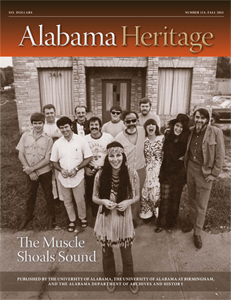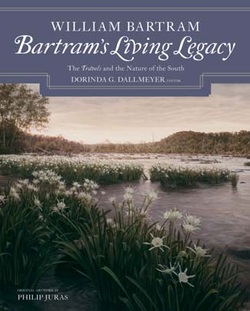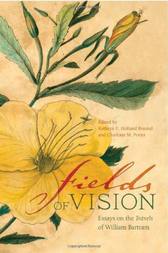|
On the cover: Cher and friends gather in front of Muscle Shoals Sound. (Stephen Paley)
|
FEATURE ABSTRACTS
Creating "The Muscle Shoals Sound"
By Charles L. Hughes
By Charles L. Hughes
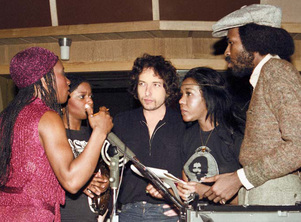 Bob Dylan (center), discussing a song with his backup vocalists, was among the rock luminaries who recorded at Muscle Shoals Sound in the 1970s. (Dick Cooper)
Bob Dylan (center), discussing a song with his backup vocalists, was among the rock luminaries who recorded at Muscle Shoals Sound in the 1970s. (Dick Cooper)
Many of the musical hits over the past fifty years have been linked to Muscle Shoals and its production studios. Thanks to the efforts and enthusiasms of several men—including Rick Hall, James Joiner, Billy Sherrill, and Tom Stafford—the “Muscle Shoals sound” soon pervaded radio waves across the United States. Artists as varied as Cher, Wilson Pickett, the Osmonds, and Bob Dylan travelled to Alabama in pursuit of musical excellence, and today the area still hosts acts such as The Black Keys. It has also attracted attention from organizations such as Beats Electronics, which aims to restore some of the original studios and partner in music education efforts for community children—proof that Muscle Shoals and its legendary sound continue to influence the musical world.
Additional Information
For additional information, please see the following article in the Encyclopedia of Alabama: http://www.encyclopediaofalabama.org/face/Article.jsp?id=h-1448.
About the Author
Charles L. Hughes is assistant professor of history at Oklahoma State University. A native of Wisconsin, he received his PhD in history from the University of Wisconsin-Madison. In 2015 the University of North Carolina Press will publish his first book, Country Soul: Making Music and Making Race in the American South. He has taught and written extensively on race, music, and southern history.
For additional information, please see the following article in the Encyclopedia of Alabama: http://www.encyclopediaofalabama.org/face/Article.jsp?id=h-1448.
About the Author
Charles L. Hughes is assistant professor of history at Oklahoma State University. A native of Wisconsin, he received his PhD in history from the University of Wisconsin-Madison. In 2015 the University of North Carolina Press will publish his first book, Country Soul: Making Music and Making Race in the American South. He has taught and written extensively on race, music, and southern history.
An Invisible Map Revealed: The First State Seal of Alabama
By David M. Robb Jr.
By David M. Robb Jr.
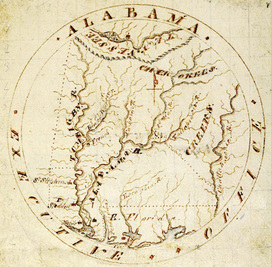 In his February 16, 1818, letter to Secretary of State John Quincy Adams, Gov. William Wyatt Bibb enclosed this small ink and watercolor drawing (much enlarged here) on paper. It was used by Moritz Furst to create the invisible map of Alabama featured on the first official seal of Alabama.
(National Archives and Records Administration)
In his February 16, 1818, letter to Secretary of State John Quincy Adams, Gov. William Wyatt Bibb enclosed this small ink and watercolor drawing (much enlarged here) on paper. It was used by Moritz Furst to create the invisible map of Alabama featured on the first official seal of Alabama.
(National Archives and Records Administration)
Thanks to advances in technology, historians have recently discovered an early state seal of Alabama. The discovery of this seal, which has the rare use of a map in its center, opens new lines of historical exploration and allows scholars to reflect in new ways on the values of Alabama’s founders. Alabama’s first governor helped shape this seal, which features the state’s major waterways, and it was created by Moritz Furst, a prominent nineteenth-century medal-maker. David M. Robb Jr. traces the history of this seal, exploring its influence on later iterations of seals and what it suggests about the state’s early history.
Additional Information
Read more about the Alabama Bicentennial Commission and plans to celebrate our state's 200th birthday here: http://alabama200.org/
Additional Information
Read more about the Alabama Bicentennial Commission and plans to celebrate our state's 200th birthday here: http://alabama200.org/
About the Author
David M. Robb Jr. is an art historian, has served as a museum director, and is now a regional historian and museum consultant. He has been intrigued by map making and design ever since his college art history studies. Following curator appointments at the National Gallery of Art, the Walker Art Center, and the Kimbell Art Museum, Robb served as director of the Telfair Museum in Savannah, Georgia, and at the Huntsville Museum of Art (1984–1995). Since retiring, he has been researching diverse topics, including the architectural photography of Frances Benjamin Johnston and the natural ice trade in the South, and has written articles about the adventurer Zachariah Cox and the origins of Alabama’s boundaries for the Encyclopedia of Alabama. He recently identified Thomas Freeman’s 1807 “Mother Map” for Madison County, Alabama. Robb currently serves on the boards of the Friends of the Alabama Archives and the Alabama Historical Association. Robb would like to thank Meredith McDonough for her excellent work in producing the high-resolution scans of the seal.
David M. Robb Jr. is an art historian, has served as a museum director, and is now a regional historian and museum consultant. He has been intrigued by map making and design ever since his college art history studies. Following curator appointments at the National Gallery of Art, the Walker Art Center, and the Kimbell Art Museum, Robb served as director of the Telfair Museum in Savannah, Georgia, and at the Huntsville Museum of Art (1984–1995). Since retiring, he has been researching diverse topics, including the architectural photography of Frances Benjamin Johnston and the natural ice trade in the South, and has written articles about the adventurer Zachariah Cox and the origins of Alabama’s boundaries for the Encyclopedia of Alabama. He recently identified Thomas Freeman’s 1807 “Mother Map” for Madison County, Alabama. Robb currently serves on the boards of the Friends of the Alabama Archives and the Alabama Historical Association. Robb would like to thank Meredith McDonough for her excellent work in producing the high-resolution scans of the seal.
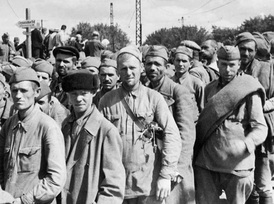 Like Harold Marlowe in Stalag Luft IV, these Russian POWs in Stalg Luft VIII, also in Poland, were force-marched for three months, covering about 600 miles, as the Russian army advanced westward. Both camps held prisoners from a number of different countries. (Wikimedia Commons)
Like Harold Marlowe in Stalag Luft IV, these Russian POWs in Stalg Luft VIII, also in Poland, were force-marched for three months, covering about 600 miles, as the Russian army advanced westward. Both camps held prisoners from a number of different countries. (Wikimedia Commons)
Alabama's Jewish Servicemen in World War II
By Dan J. Puckett
During the Second World War, Jewish servicemen faced a particularly challenging set of circumstances, as their efforts were directly tied to the fate of their people. In this article, based on his new book, Dan Puckett explores Alabama’s Jewish servicemen, considering their history, their wartime actions, their post-war lives, and the contributions they made to Alabama and the broader world.
About the Author
Dan J. Puckett is an associate professor of history at Troy University. He received his PhD at Mississippi State University and is the author of In the Shadow of Hitler: Alabama’s Jews, the Second World War, and the Holocaust, published by the University of Alabama Press. His work has appeared in Holocaust and Genocide Studies, Alabama Heritage, and Southern Jewish History, among other places. Puckett has been a Starkoff Fellow at the Jacob Rader Marcus Center of the American Jewish Archives, a Chancellor’s Fellow at Troy University, a member of the Alabama Holocaust Commission, and serves on the Board of Directors for the Alabama Historical Association and the Board of Trustees for the Southern Jewish Historical Society.
Additional Information
For additional information on this topic, please consult the author’s book In the Shadow of Hitler: Alabama’s Jews, the Second World War, and the Holocaust (Modern South, University of Alabama Press, 2014).
By Dan J. Puckett
During the Second World War, Jewish servicemen faced a particularly challenging set of circumstances, as their efforts were directly tied to the fate of their people. In this article, based on his new book, Dan Puckett explores Alabama’s Jewish servicemen, considering their history, their wartime actions, their post-war lives, and the contributions they made to Alabama and the broader world.
About the Author
Dan J. Puckett is an associate professor of history at Troy University. He received his PhD at Mississippi State University and is the author of In the Shadow of Hitler: Alabama’s Jews, the Second World War, and the Holocaust, published by the University of Alabama Press. His work has appeared in Holocaust and Genocide Studies, Alabama Heritage, and Southern Jewish History, among other places. Puckett has been a Starkoff Fellow at the Jacob Rader Marcus Center of the American Jewish Archives, a Chancellor’s Fellow at Troy University, a member of the Alabama Holocaust Commission, and serves on the Board of Directors for the Alabama Historical Association and the Board of Trustees for the Southern Jewish Historical Society.
Additional Information
For additional information on this topic, please consult the author’s book In the Shadow of Hitler: Alabama’s Jews, the Second World War, and the Holocaust (Modern South, University of Alabama Press, 2014).
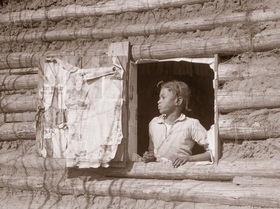 This evocative portrait by Arthur Rothstein of Artella Bendolph looking from the window of her newspaper-lined cabin illustrates the primitive living conditions in Gee’s Bend before the federal government built the new “Roosevelt houses,” offered with five acres of land for $1,250. (Library of Congress)
This evocative portrait by Arthur Rothstein of Artella Bendolph looking from the window of her newspaper-lined cabin illustrates the primitive living conditions in Gee’s Bend before the federal government built the new “Roosevelt houses,” offered with five acres of land for $1,250. (Library of Congress)
Coming of Age in Gee's Bend
By Mary Stanton
When anthropologist Olive Stone first discovered Gee’s Bend, it was a little-known and under-studied community. The Bend, as it was called, remained shielded from the full extent of the Great Depression by its residents’ unique community values and practices. When the Depression’s effects did reach the Bend, federal officials found a different kind of life than they anticipated; the independent and self-sufficient Benders did not always embrace the restrictions tied to federal intervention. Throughout that era, the Benders found ways to adapt to changing circumstances while maintaining a unique and compelling heritage—a challenge they continue to meet today.
About the Author
Mary Stanton is a freelance writer who specializes in southern white civil rights activism. Her work includes From Selma To Sorrow: The Life & Death of Viola Liuzzo (1998), Freedom Walk (2003), Journey Toward Justice (2006), and The Hand of Esau (2006). She has also written for Southern Exposure, The Journal of Southern History, Griot, The Gulf South Historical Review, and Southern Jewish History. Her latest book, Alabama Reds, Whites, Blacks & Bluebloods, a social history of the Great Depression and the New Deal in Alabama, is currently under contract with the University of Alabama Press. Stanton has taught at the University of Idaho, New Jersey’s College of St. Elizabeth, and Rutgers University.
Additional Information
The author recommends the following resources on Gee’s Bend:
Cynthia Griggs Fleming, In The Shadow of Selma: The Continuing Struggle for Civil Rights in the Rural South, (New York: Rowman & Littlefield, 2004), 67-98.
J.R. Moehringer, “Crossing Over,” The Los Angeles Times, August 22, 1999.
Linda Hunt Beckman, “Black Rural Women, White Urban Entrepreneurs and the American Dream,” BlackCommentator.com Issue #456 (January 26, 2012).
Olive Stone, Oral History Interviews August 13, 1975 through October 14, 1975, G-0059-4. (#4007) Southern Oral History Program, Southern Historical Collection, Wilson Library, University of North Carolina at Chapel Hill. Interviewed by Sherna Berger Gluck.
John D’Julio, Bruce Kuertin and M.G. Trend, From Fields of Promise, documentary film. Media Production Group, Auburn Television, Auburn University, Auburn University Alabama, 1993.
By Mary Stanton
When anthropologist Olive Stone first discovered Gee’s Bend, it was a little-known and under-studied community. The Bend, as it was called, remained shielded from the full extent of the Great Depression by its residents’ unique community values and practices. When the Depression’s effects did reach the Bend, federal officials found a different kind of life than they anticipated; the independent and self-sufficient Benders did not always embrace the restrictions tied to federal intervention. Throughout that era, the Benders found ways to adapt to changing circumstances while maintaining a unique and compelling heritage—a challenge they continue to meet today.
About the Author
Mary Stanton is a freelance writer who specializes in southern white civil rights activism. Her work includes From Selma To Sorrow: The Life & Death of Viola Liuzzo (1998), Freedom Walk (2003), Journey Toward Justice (2006), and The Hand of Esau (2006). She has also written for Southern Exposure, The Journal of Southern History, Griot, The Gulf South Historical Review, and Southern Jewish History. Her latest book, Alabama Reds, Whites, Blacks & Bluebloods, a social history of the Great Depression and the New Deal in Alabama, is currently under contract with the University of Alabama Press. Stanton has taught at the University of Idaho, New Jersey’s College of St. Elizabeth, and Rutgers University.
Additional Information
The author recommends the following resources on Gee’s Bend:
Cynthia Griggs Fleming, In The Shadow of Selma: The Continuing Struggle for Civil Rights in the Rural South, (New York: Rowman & Littlefield, 2004), 67-98.
J.R. Moehringer, “Crossing Over,” The Los Angeles Times, August 22, 1999.
Linda Hunt Beckman, “Black Rural Women, White Urban Entrepreneurs and the American Dream,” BlackCommentator.com Issue #456 (January 26, 2012).
Olive Stone, Oral History Interviews August 13, 1975 through October 14, 1975, G-0059-4. (#4007) Southern Oral History Program, Southern Historical Collection, Wilson Library, University of North Carolina at Chapel Hill. Interviewed by Sherna Berger Gluck.
John D’Julio, Bruce Kuertin and M.G. Trend, From Fields of Promise, documentary film. Media Production Group, Auburn Television, Auburn University, Auburn University Alabama, 1993.
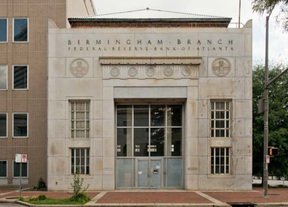 The Federal Reserve Bank of Atlanta, Birmingham Branch, built 1926-1927. (Robin McDonald)
The Federal Reserve Bank of Atlanta, Birmingham Branch, built 1926-1927. (Robin McDonald)
Places in Peril 2014
By Michael Panhorst
Each year, Alabama Heritage, the Alabama Historical Commission, and the Alabama Trust for Historic Preservation identify historic structures in dire need of restoration or other intervention. This year’s list included six such structures that require urgent action to help preserve their historic significance.
About the Author
Michael Panhorst, PhD, coordinated the Places in Peril program in 2014. He is a historian of art and architecture and a member of the board of the Alabama Trust for Historic Preservation. His book, The Memorial Art and Architecture of Vicksburg National Military Park, is forthcoming this autumn from Kent State University Press. His photo essay about the earliest Civil War monuments is forthcoming in Southern Cultures 20, no. 4 (November 2014).
Additional Information
For information about Places in Peril, and to help with preservation, please see www.alabamatrust.info. You may also contact the Alabama Trust for Historic Preservation by mail at Alabama Trust for Historic Preservation, UWA Station 45, Livingston, AL 35470, by calling (205) 652-3497, or sending an email to [email protected].
By Michael Panhorst
Each year, Alabama Heritage, the Alabama Historical Commission, and the Alabama Trust for Historic Preservation identify historic structures in dire need of restoration or other intervention. This year’s list included six such structures that require urgent action to help preserve their historic significance.
About the Author
Michael Panhorst, PhD, coordinated the Places in Peril program in 2014. He is a historian of art and architecture and a member of the board of the Alabama Trust for Historic Preservation. His book, The Memorial Art and Architecture of Vicksburg National Military Park, is forthcoming this autumn from Kent State University Press. His photo essay about the earliest Civil War monuments is forthcoming in Southern Cultures 20, no. 4 (November 2014).
Additional Information
For information about Places in Peril, and to help with preservation, please see www.alabamatrust.info. You may also contact the Alabama Trust for Historic Preservation by mail at Alabama Trust for Historic Preservation, UWA Station 45, Livingston, AL 35470, by calling (205) 652-3497, or sending an email to [email protected].
To read about more places in peril, click here for our Places in Peril blog.
DEPARTMENT ABSTRACTS
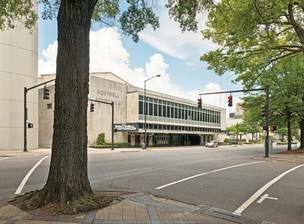 In 1957 the auditorium was given a modern
In 1957 the auditorium was given a modern façade, designed by Birmingham architect
Charles McCauley. (Robin McDonald)
Southern Architecture and Preservation
Birmingham's Boutwell Auditorium
By Glenn T. Eskew
For ninety years, Birmingham’s Boutwell Auditorium has stood at the center of a wide swath of history, hosting events that represent the cultural transitions of twenty- and twenty-first-century America. For music, sporting events, politics, and civil and human rights causes, the structure has been a central landmark. Historian Glenn T. Eskew recounts the building’s rich history and makes a compelling case for its designation as a National Historic Landmark.
About the Author
Glenn T. Eskew teaches southern history at Georgia State University in Atlanta. He is the author of But for Birmingham: The Local and National Movements in the Civil Rights Struggle (University of North Carolina Press, 1997). Robert Gamble, standing editor of the “Southern Architecture and Preservation” department of Alabama Heritage, has recently retired as senior architectural historian for the Alabama Historical Commission.
Birmingham's Boutwell Auditorium
By Glenn T. Eskew
For ninety years, Birmingham’s Boutwell Auditorium has stood at the center of a wide swath of history, hosting events that represent the cultural transitions of twenty- and twenty-first-century America. For music, sporting events, politics, and civil and human rights causes, the structure has been a central landmark. Historian Glenn T. Eskew recounts the building’s rich history and makes a compelling case for its designation as a National Historic Landmark.
About the Author
Glenn T. Eskew teaches southern history at Georgia State University in Atlanta. He is the author of But for Birmingham: The Local and National Movements in the Civil Rights Struggle (University of North Carolina Press, 1997). Robert Gamble, standing editor of the “Southern Architecture and Preservation” department of Alabama Heritage, has recently retired as senior architectural historian for the Alabama Historical Commission.
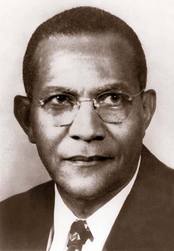 Charles Gomillion, a sociology professor at Tuskegee Institute, led the effort to integrate
the Macon County government in the 1964 election. (Tuskegee University Archives)
Charles Gomillion, a sociology professor at Tuskegee Institute, led the effort to integrate
the Macon County government in the 1964 election. (Tuskegee University Archives)
Becoming Alabama
Quarter By Quarter
By Joseph W. Pearson, Megan L. Bever, and Matthew L. Downs
Editor’s Note--Alabama Heritage, the Summersell Center for Study of the South, the University of Alabama Department of History, and the Alabama Tourism Department offer this department as a part of the statewide “Becoming Alabama” initiative—a cooperative venture of state organizations to commemorate Alabama’s experiences related to the Creek War, the Civil War, and the civil rights movement. Quarter by quarter we will take you to the corresponding seasons 200, 150, and 50 years ago—sometimes describing pivotal events, sometimes describing daily life, but always illuminating a world in flux. We will wait for the ultimate outcomes as our forebears did—over time. For those joining the story in progress, you can find earlier quarters on our website at www.AlabamaHeritage.com/BecomingAlabama.
This quarter’s installment of “Becoming Alabama” returns to the fate of Big Warrior and his people. It explores the effects of the Civil War on Alabama’s white women, considering the hardships of life under the blockade—and the innovation those hardships prompted. It also explores the lives of women such as Kate Cumming, who supported the war effort as nurses. And the column’s look at the civil rights movement revisits the 1964 elections in Tuskegee, in which community members tried out very different strategies for securing local government offices for African Americans.
About the Authors
Joseph W. Pearson is assistant professor of history at Union College. His dissertation, completed at the University of Alabama, explores the political culture of the American Whigs, specifically probing the shared underpinnings of their political thought and moral temper across class, gender, and section.
Megan L. Bever is assistant professor of history at Missouri Southern State University. Her dissertation, completed at the University of Alabama, explores alcohol, morality, and citizenship in the Civil War era.
Matthew L. Downs (PhD, Alabama) is an assistant professor of history at the University of Mobile. His dissertation focused on the federal government’s role in the economic development of the Tennessee Valley.
Additional Information
For more information on Kate Cumming, please see Jessica Fordham Kidd’s article “Patriotism Over Propriety: Confederate Nurse Kate Cumming,” Alabama Heritage 89 (Summer 2008).
Quarter By Quarter
By Joseph W. Pearson, Megan L. Bever, and Matthew L. Downs
Editor’s Note--Alabama Heritage, the Summersell Center for Study of the South, the University of Alabama Department of History, and the Alabama Tourism Department offer this department as a part of the statewide “Becoming Alabama” initiative—a cooperative venture of state organizations to commemorate Alabama’s experiences related to the Creek War, the Civil War, and the civil rights movement. Quarter by quarter we will take you to the corresponding seasons 200, 150, and 50 years ago—sometimes describing pivotal events, sometimes describing daily life, but always illuminating a world in flux. We will wait for the ultimate outcomes as our forebears did—over time. For those joining the story in progress, you can find earlier quarters on our website at www.AlabamaHeritage.com/BecomingAlabama.
This quarter’s installment of “Becoming Alabama” returns to the fate of Big Warrior and his people. It explores the effects of the Civil War on Alabama’s white women, considering the hardships of life under the blockade—and the innovation those hardships prompted. It also explores the lives of women such as Kate Cumming, who supported the war effort as nurses. And the column’s look at the civil rights movement revisits the 1964 elections in Tuskegee, in which community members tried out very different strategies for securing local government offices for African Americans.
About the Authors
Joseph W. Pearson is assistant professor of history at Union College. His dissertation, completed at the University of Alabama, explores the political culture of the American Whigs, specifically probing the shared underpinnings of their political thought and moral temper across class, gender, and section.
Megan L. Bever is assistant professor of history at Missouri Southern State University. Her dissertation, completed at the University of Alabama, explores alcohol, morality, and citizenship in the Civil War era.
Matthew L. Downs (PhD, Alabama) is an assistant professor of history at the University of Mobile. His dissertation focused on the federal government’s role in the economic development of the Tennessee Valley.
Additional Information
For more information on Kate Cumming, please see Jessica Fordham Kidd’s article “Patriotism Over Propriety: Confederate Nurse Kate Cumming,” Alabama Heritage 89 (Summer 2008).

Alabama Governors
Alabama's Territorial Governors
By Samuel L. Webb
From the Editor: With great pleasure, we introduce the long-awaited “Alabama Governors” department, which will offer Alabama Heritage readers “nutshell” biographies of our historic heads of state. Dr. Samuel L. Webb will be creating the biographical capsules, based on the book he coedited with Margaret E. Armbrester, Alabama Governors: A Political History of the State—now in its second edition with the University of Alabama Press. This quarter, we begin with Webb’s introduction to the gubernatorial experience in Alabama and a synopsis of the administrations of the men who served as governors during Alabama’s pre-statehood years. In upcoming issues, we will present the governors one by one, in the order in which they served. We would like to thank Samuel Webb, Margaret Armbrester, the numerous scholars who developed the material, the University of Alabama Press, and the Comer Foundation for their roles in the creation and support of the book. We also thank the Alabama Department of Archives and History for partnering with us in funding Robin McDonald’s new photographs of the state-era governors’ portraits.
In the first installment of this column, Samuel L. Webb explores the first men who governed Alabama prior to statehood, first when it was part of the Mississippi Territory and then when it was established on its own as the Alabama Territory. In this era, Alabama received little government focus, but these men—William Wyatt Bibb in particular—helped shape its course into statehood.
About the Author
Samuel L. Webb, a native of York, Alabama, holds a Juris Doctor degree from the University of Alabama School of Law and a PhD in history from the University of Arkansas. He taught history at the University of Alabama at Birmingham from 1988 to 2009 and is now an adjunct professor at the University of Alabama.
Alabama's Territorial Governors
By Samuel L. Webb
From the Editor: With great pleasure, we introduce the long-awaited “Alabama Governors” department, which will offer Alabama Heritage readers “nutshell” biographies of our historic heads of state. Dr. Samuel L. Webb will be creating the biographical capsules, based on the book he coedited with Margaret E. Armbrester, Alabama Governors: A Political History of the State—now in its second edition with the University of Alabama Press. This quarter, we begin with Webb’s introduction to the gubernatorial experience in Alabama and a synopsis of the administrations of the men who served as governors during Alabama’s pre-statehood years. In upcoming issues, we will present the governors one by one, in the order in which they served. We would like to thank Samuel Webb, Margaret Armbrester, the numerous scholars who developed the material, the University of Alabama Press, and the Comer Foundation for their roles in the creation and support of the book. We also thank the Alabama Department of Archives and History for partnering with us in funding Robin McDonald’s new photographs of the state-era governors’ portraits.
In the first installment of this column, Samuel L. Webb explores the first men who governed Alabama prior to statehood, first when it was part of the Mississippi Territory and then when it was established on its own as the Alabama Territory. In this era, Alabama received little government focus, but these men—William Wyatt Bibb in particular—helped shape its course into statehood.
About the Author
Samuel L. Webb, a native of York, Alabama, holds a Juris Doctor degree from the University of Alabama School of Law and a PhD in history from the University of Arkansas. He taught history at the University of Alabama at Birmingham from 1988 to 2009 and is now an adjunct professor at the University of Alabama.
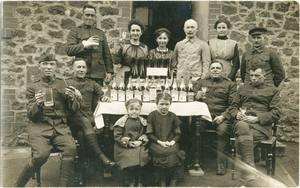 Soldiers from the Third Army make toasts with European civilians. The sign on the table reads: “The Temperance Club of the Rhine.” (W. S. Hoole Special Collections Library)
Soldiers from the Third Army make toasts with European civilians. The sign on the table reads: “The Temperance Club of the Rhine.” (W. S. Hoole Special Collections Library)
Revealing Hidden Collections
Glimpses of the Great War at Home and Abroad
By Donnelly Lancaster Walton
While history most notably gets recorded through official documents, many valuable insights emerge from the ephemera of the everyday lives of people living through significant events. This quarter’s installment of “Revealing Hidden Collections” highlights several such items from the University of Alabama Libraries Division of Special Collections. By exploring the collection’s letters, photographs, and mementoes, researchers gain an important understanding of how average Americans experienced World War I.
About the Author
Birmingham archives for several years, she joined the faculty of the University of Alabama Libraries as the archival access coordinator in 2001. Louis A. Pitschmann, standing editor of the “Revealing Hidden Collections” department of Alabama Heritage, is dean of the University Libraries at the University of Alabama and director of the Alabama Center for the Book, which co-sponsor this department.
Additional Information
Researchers may go to Acumen at http://acumen.lib.ua.edu/ to search or browse the digital collections, or they may visit the reading room and view them in person. The Division of Special Collections has also created an exhibit, “Glimpses of the Great War Abroad and At Home,” that showcases archival materials from the collections. While this examination focuses on manuscripts, photographs, and artifacts, the Libraries Division of Special Collections also holds numerous published items relating to World War I. Researchers can search for these in the university libraries’ online catalog at www.lib.ua.edu.
Glimpses of the Great War at Home and Abroad
By Donnelly Lancaster Walton
While history most notably gets recorded through official documents, many valuable insights emerge from the ephemera of the everyday lives of people living through significant events. This quarter’s installment of “Revealing Hidden Collections” highlights several such items from the University of Alabama Libraries Division of Special Collections. By exploring the collection’s letters, photographs, and mementoes, researchers gain an important understanding of how average Americans experienced World War I.
About the Author
Birmingham archives for several years, she joined the faculty of the University of Alabama Libraries as the archival access coordinator in 2001. Louis A. Pitschmann, standing editor of the “Revealing Hidden Collections” department of Alabama Heritage, is dean of the University Libraries at the University of Alabama and director of the Alabama Center for the Book, which co-sponsor this department.
Additional Information
Researchers may go to Acumen at http://acumen.lib.ua.edu/ to search or browse the digital collections, or they may visit the reading room and view them in person. The Division of Special Collections has also created an exhibit, “Glimpses of the Great War Abroad and At Home,” that showcases archival materials from the collections. While this examination focuses on manuscripts, photographs, and artifacts, the Libraries Division of Special Collections also holds numerous published items relating to World War I. Researchers can search for these in the university libraries’ online catalog at www.lib.ua.edu.
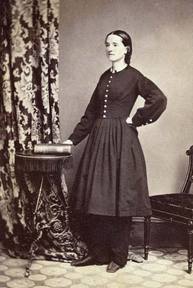 Dr. Mary Edwards Walker was the first woman to win the Congressional Medal of Honor. (Library of Congress)
Dr. Mary Edwards Walker was the first woman to win the Congressional Medal of Honor. (Library of Congress)
Portraits & Landscapes
Remembering A Female Civil War POW
By Greg Starnes
Although one of the only women memorialized by a marker commemorating her time as a Civil War POW, Lizzie Stewart remains little-known today. Author Greg Starnes reflects on her life, particularly the hardships she faced in raising a family during the war.
About the Author
Greg Starnes is a novelist, journalist, and Civil War historian who lives in Fort Payne, Alabama, and is working on a novel about the capture of southern women in 1864.
Remembering A Female Civil War POW
By Greg Starnes
Although one of the only women memorialized by a marker commemorating her time as a Civil War POW, Lizzie Stewart remains little-known today. Author Greg Starnes reflects on her life, particularly the hardships she faced in raising a family during the war.
About the Author
Greg Starnes is a novelist, journalist, and Civil War historian who lives in Fort Payne, Alabama, and is working on a novel about the capture of southern women in 1864.
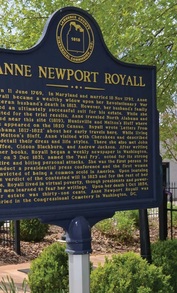 Historical marker for Anne Newport Royall, corner of Court and Market Streets, Moulton, Alabama. (L. J. Davenport)
Historical marker for Anne Newport Royall, corner of Court and Market Streets, Moulton, Alabama. (L. J. Davenport)
Nature Journal
Mrs. Royall's Judge, or, a Tale of Two Historical Markers
By L. J. Davenport
The location of two different historical markers in Moulton, Alabama, causes Larry Davenport to ruminate on the intersection between several distinct parts of history: the 1819 trip Anne Newport Royall made to the area, and local Judge Thomas Minott Peters. The lives of these two individuals highlight the diverse and often divisive topics of their time, from legal precedents to the rights of women, new fern species to the role of slavery in the state.
About the Author
Larry Davenport is a professor of biology at Samford University, Birmingham, Alabama.
Mrs. Royall's Judge, or, a Tale of Two Historical Markers
By L. J. Davenport
The location of two different historical markers in Moulton, Alabama, causes Larry Davenport to ruminate on the intersection between several distinct parts of history: the 1819 trip Anne Newport Royall made to the area, and local Judge Thomas Minott Peters. The lives of these two individuals highlight the diverse and often divisive topics of their time, from legal precedents to the rights of women, new fern species to the role of slavery in the state.
About the Author
Larry Davenport is a professor of biology at Samford University, Birmingham, Alabama.
Reading the Southern Past
William Bartram, Naturalist and Traveler
By Stephen Goldfarb
Stephen Goldfarb looks back at the life and work of William Bartram through several new books: The Golden Age of Botanical Art (University of Chicago Press, 2013) by Martyn Rix; Fields of Vision: Essays on the Travels of William Bartram (University of Alabama Press, 2010), edited by Kathryn E. Holland Braund and Charlotte M. Porter; and Bartram’s Living Legacy: The Travels and the Nature of the South (Mercer University Press, 2010), edited by Dorinda Dallmeyer.
About the Author
Stephen Goldfarb holds a PhD in the history of science and technology. He retired from a public library in 2003.
William Bartram, Naturalist and Traveler
By Stephen Goldfarb
Stephen Goldfarb looks back at the life and work of William Bartram through several new books: The Golden Age of Botanical Art (University of Chicago Press, 2013) by Martyn Rix; Fields of Vision: Essays on the Travels of William Bartram (University of Alabama Press, 2010), edited by Kathryn E. Holland Braund and Charlotte M. Porter; and Bartram’s Living Legacy: The Travels and the Nature of the South (Mercer University Press, 2010), edited by Dorinda Dallmeyer.
About the Author
Stephen Goldfarb holds a PhD in the history of science and technology. He retired from a public library in 2003.
